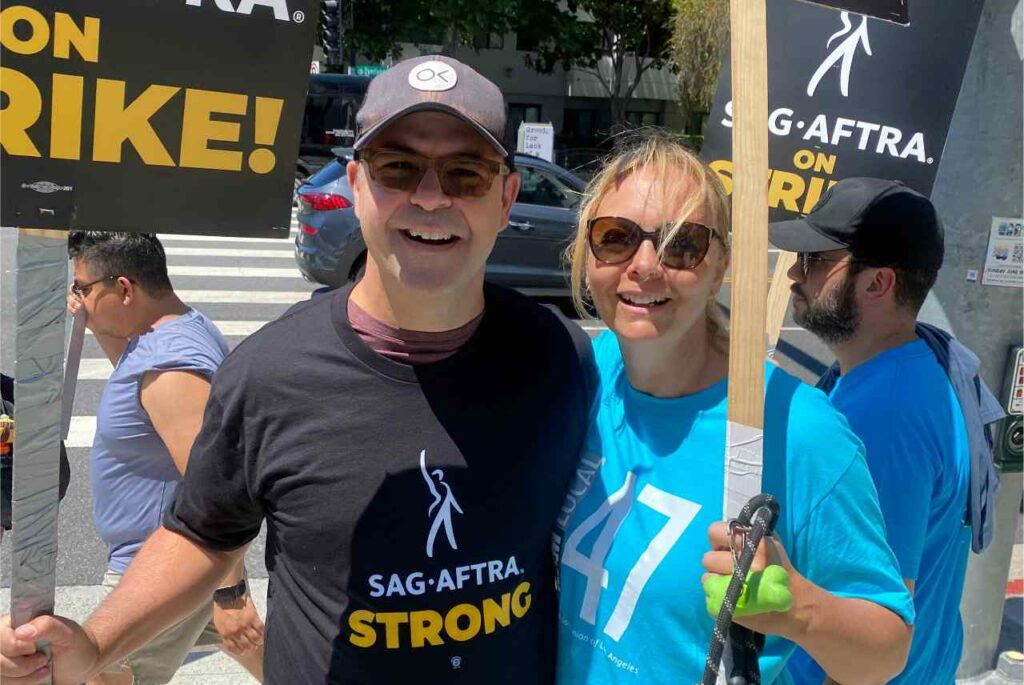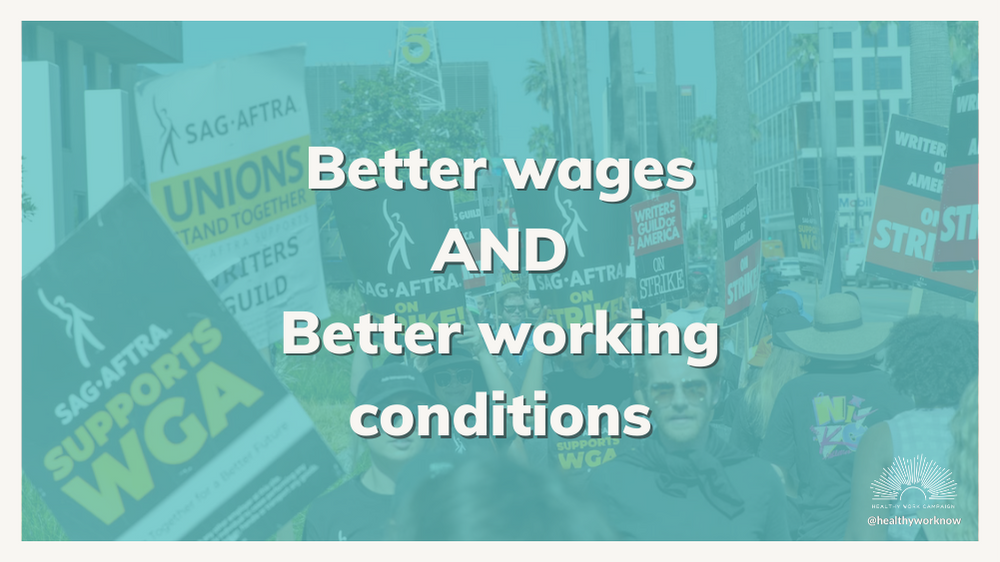by Marnie Dobson Zimmerman, PhD
What is a “hot labor summer”
Los Angeles, California has been called the “epicenter” of the “hot labor summer” where one hundred thousand hotel workers, writers, actors and city staff are bearing the heat to fight for fair pay, job security and better working conditions–amidst low unemployment and a rising cost of living.
I walked the picket line at the end of July outside Sony Pictures Studios with an actor and good friend Ross MacKenzie to support the SAG-AFTRA and Writers Guild of America strikes. I proudly wore my spouse’s union t-shirt for American Federation of Musicians (AFM) Local 47 as the musicians were also picketing to support the writers and actors. Although it seems like there is very little in common between these different kinds of workers, all are exercising their power to make a collective difference in the quality of their jobs.

Marnie attending a SAG-AFTRA/WGA picket with AFM Local 47 (July 2023)
A little backstory…
It was not my first picket line. My first year of graduate school at the University of California, Irvine I joined my fellow student employees of UAW 2865 (teaching assistants and tutors) in a “recognition strike,” urging the UC system to recognize our labor as employees. We ultimately won that fight, and during the negotiations of our second contract I helped to organize an unfair labor practice strike. What I found myself convincing my fellow student workers of was that (1) our labor was valuable to the University and should be rewarded fairly, and (2) fair pay raises and benefits would not just be handed over, unfortunately.
Popularity of unions amidst income inequality in the U.S.
Over 70% of US workers say they approve of unions–the highest since 1965, according to Gallup. Workers from around the country – from Starbucks and Amazon workers, to delivery drivers (UPS and the Teamsters recently settled on a tentative agreement under threat of a strike), to Southern California hotel workers, and writers and actors – are using their collective power to fight for meaningful improvements in their pay and working conditions. In the case of Starbucks and Amazon, workers face illegal abuse of their labor rights by top leaders at these companies.
The power invested in American corporations and the wealthy has made the fight for adequate and fair pay an ongoing struggle with the US having some of the lowest unionization rates in the world. What the evidence tells us, however, is that the decline of unions (among other factors) coincides with a massive boom in income inequality (with the US having one of the highest rates of inequality among wealthy countries). The top 1% take home 21% of all the income in the United States (EPI 2023). The average income for the top 1% is $1.3 million, whereas the average for the 99% is $50,000. The causes of widening income inequality are multiple and complex. But the consequences of income inequality are very clear–poorer national health indicators, and more “deaths of despair.” Along with income inequality, the quality of work is declining.
Can anything be done beyond improving wages?
Enter the Healthy Work Campaign. The Healthy Work Campaign encourages workers to consider organizing a union as a way of achieving healthier work.
Unionization provides a chance at a level playing field with an employer, the best opportunity for workers to participate in collective decisions about their economic value, and the quality of their work, also increasing job control. As well as economic benefits, unions bargain for reasonable workloads, overtime pay, and health & safety, all of which lower the sources of stress in the workplace and help to improve the health and well-being of workers. We know from over 40 decades of scientific research that high job demands and low job control (not having a say over your job, freedom and autonomy to do your job), an imbalance between efforts and rewards, long work hours, work-family conflict, and lack of fairness or respect, can not only affect the mental and physical health of workers, but also their productivity.
There is a business case for healthy work, and a case to be made for unions increasing employee economic power, health and wellbeing. Workers covered by a union contract earn 10% more than workers without a union contract but with similar education, occupations and experience; and pay gaps due to gender or race are minimized by union contracts. States with higher union density tend to have less uninsured populations, more paid sick leave and family leave laws, and a lower rate of deaths on the job. Union members are also less likely to be depressed, worried, sad or lonely, and have higher job satisfaction, according to research from two million workers in Europe and the US.
A higher road, and a healthier way
So if unions inspire healthy work and healthy workers, why the resistance among many of the economic elite in the U.S.? That resistance is being challenged as we see younger workers being more likely to want to join a union and more employees demanding greater flexibility and work-life balance by refusing to return to pre-pandemic work schedules that require long commutes and long hours in an office environment. We are hopeful that just as some corporate leaders are recognizing the need for more sustainable business practices to fight climate change, they might also look towards business practices that are more sustainable for the health and well-being of employees.







